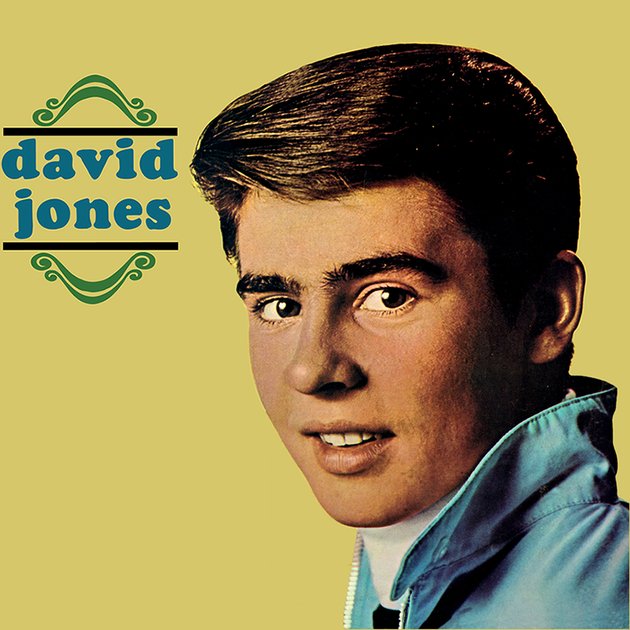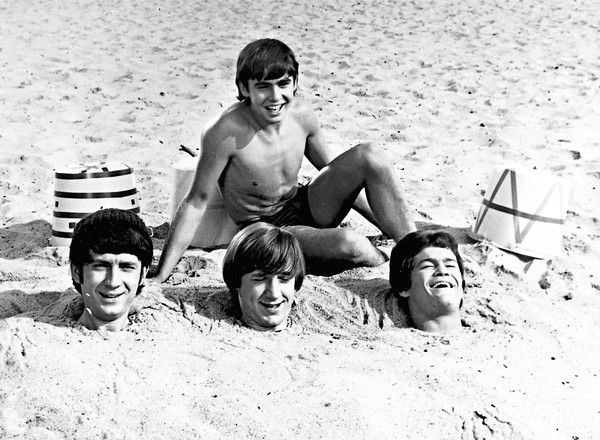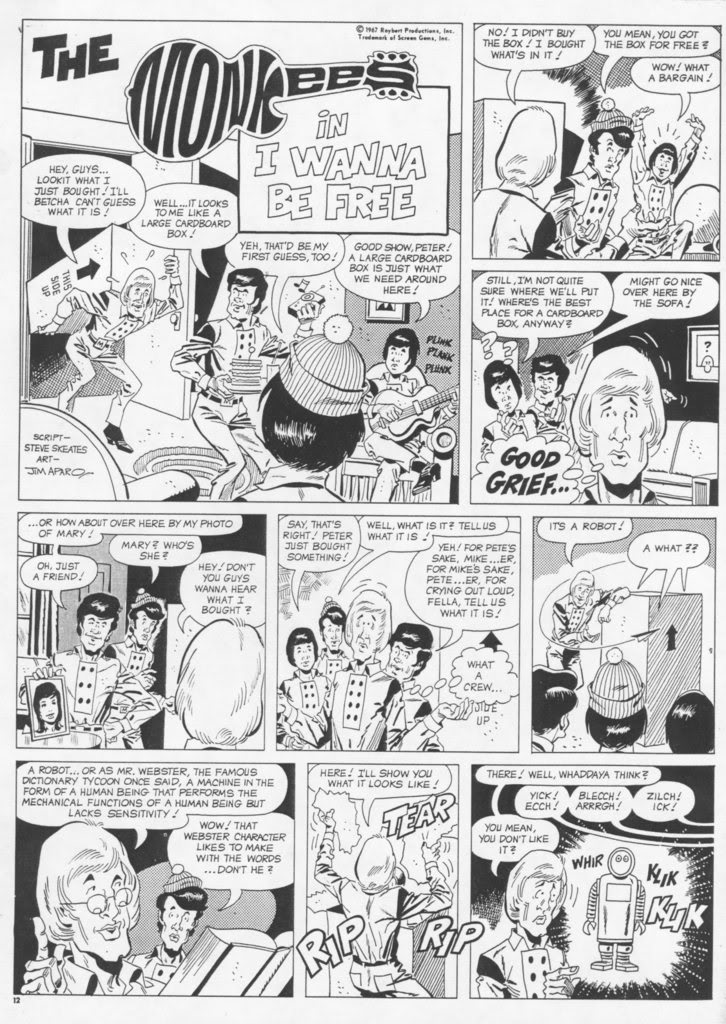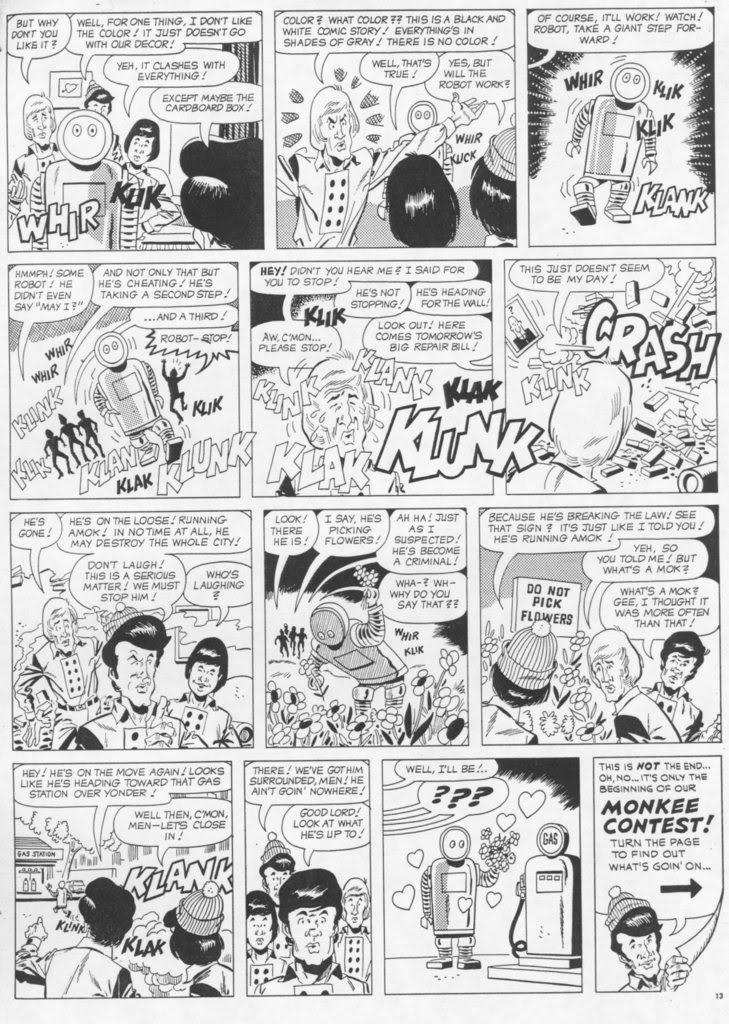‘Adios to the Manchester Cowboy’
Remembering Davy Jones
December 30, 1945-February 29, 2012
By David McGee
At least one of the good things rock journalism has done has been to discredit anyone who dumps on the Monkees anymore. The non-moptopped quartet's music, their television show and eventually the musicians themselves represent all that was good about ‘60s pop, from the lyricism of the songs written by them and for them (by some of the best writers of the day), to the outstanding arrangements and production, to their daring in going against type in the late ‘60s, plus the sometimes anarchic wit of their hit sitcom and the sheer inscrutable grooviness of their trippy, Jack Nicholson-written film Head,with its out-there soundtrack and merciless attack on the Monkees’ own manipulated success. They even overcame the ineptness and embarrassment of their first concert tour, when it was painfully obvious they had a ways to go to be a polished band, to earn the respect of the more celebrated musicians of their day, including all of the Beatles, who were big fans of the Monkees’ records and TV show (John Lennon once compared them favorably to the Marx Brothers; George Harrison was impressed by their ability to withstand the rigors of a TV show production schedule and still make quality music, and said in time “they may be the best.”)
Born as a cynical attempt to cash in on the youth revolution the Beatles had ignited, the Monkees were the brainchild of aspiring filmmakers Bob Rafelson and Bert Schneider, who advertised in Daily Variety for “Folk and Rock musicians/singers for acting roles in new T.V. series--running parts for four boys, 17-21.” Former child actor Mickey Dolenz, of Circus Boy fame, got one part; former Greenwich Village folkie Peter Tork was hired after being urged to audition by his roommate, Stephen Stills, who had been rejected for having crooked teeth; journeyman folkie Mike Nesmith, whose song “Mary Mary” had been recorded by the Butterfield Blues Band, became a Monkee after ambling into Rafelson’s office, thumping on the desk and asking, “What’s this all about?”
Davy Jones as the Artful Dodger in the Broadway musical Oliver! in a scene performed on The Ed Sullivan Show on February 9, 1964--the same night Sullivan introduced the Beatles to America. Watching from the wings as the Fab Four drove the girls wild, Jones said, ‘I want a piece of that!’
Davy Jones didn’t have to answer a newspaper ad. He was already under contract to Columbia Pictures and had recorded a solo album for Colpix Records, which was positioning him as a dreamy teen idol type. Born December 30, 1945 in Manchester, England, Jones was a working actor at age 14, appearing on the British television soap opera Coronation Street and a BBC police series, Z-Cars. No sooner had he started his acting career than did he leave it, though. When he lost his mother to leukemia, the same year he made his debut in Coronation Street, he began training to be a jockey with a fellow named Basil Foster. With connections in the legitimate theater, Foster was queried by a friend who was casting the role of the Artful Dodger in the London production of Oliver!, a musical production of Dickens’s novel Oliver Twist. With Foster’s recommendation, Jones auditioned and not only won the part, but then earned widespread critical acclaim for his portrayal. From the London stage he took the Artful Dodger to Broadway and was nominated for a Tony Award; he also sang with Judy Garland at Carnegie Hall. (Thinking he had made the big time with the Garland gig, Jones said years later, “It wasn’t until I saw Judy Garland go around the revolving door at the Russian Tea Room three times, trying to find her way out, that I realized, ‘I don’t want to be like that!”) American audiences beyond the Great White Way got their first look at Jones on February 9, 1964, when the cast of Oliver! was featured in a scene from the play on The Ed Sullivan Show. That another guest on the same show overshadowed their national TV debut is an understatement: the night in question was when the Beatles made their first appearance on Sullivan. Jones later said he watched from the wings as the Fab Four drove the girls crazy and decided, “I want a piece of that.”
David Jones, ‘My Dad,’ from his 1965 self-titled solo debut album. The song had been a hit for teen idol Paul Peterson, of The Donna Reed Show, in 1963. Peterson auditioned for The Monkees TV show, but was rejected.Jones then signed with Screen Gems, the television division of Columbia Pictures, and appeared in episodes of the hit medical drama Ben Casey and the lesser known Inger Stevens vehicle, The Farmer’s Daughter. He was also signed to Colpix Records, a division of Columbia, and cut a self-titled album as his debut. Released in 1965, David Jones contained a mix of older, British music hall numbers (including the 1911 warhorse “Any Old Iron”), dreamy teen love songs and uptempo tunes that sounded remarkably like Herman’s Hermits outtakes with Jones himself doing credible Peter Noone-style vocals.
David Jones’s first charting single, the Herman’s Hermits-like ‘What Are We Going To Do,’ from his self-titled solo debut on the Colpix, released in 1965.Though his solo recording career had not done much towards giving Jones “a piece of that,” when he joined the Monkees cast he did have a fan club boating 12,000 members. He may have been emulating Peter Noone on his solo records, but as a Monkee, the cute, diminutive, Beatle-banged Jones was, in essence, the Paul McCartney character, the cute one.
David Jones, ‘Any Old Iron,’ from his 1965 self-titled solo debut album. The song is a vintage British music hall number written by Charles Collins, Fred Terry and E.A. Sheppard. The signature song of British composer/singer/comedian Harry Champion, whose hit version was released in 191, 'Any Old Iron' has also been recorded by Peter Sellers, Kermit the Frog, Lonnie Donegan, and Roger Daltrey (accompanied by the Chieftains), and the animated Paul McCartney mentions it in Yellow Submarine.The Monkees were given an opportunity to generate their own musical content, but their efforts in the recording studio were, according to Peter Tork, “directionless and musically unproductive”; Mike Nesmith described their recordings as “real garage band stuff.” Enter 32-year-old music publishing dynamo Don Kirshner, president of Screen Gems/Columbia music, whose Aldon Music company had nurtured the careers of some of the finest young songwriters of the day--Carole King and Gerry Goffin; Neil Sedaka and Howard Greenfield; Barry Mann and Cynthia Weil; Neil Diamond; Bobby Darin, and others. Told by producers Rafelson and Schneider, “We need a miracle!” Kirshner immediately had his writers cranking out songs and assembled a band of top studios hands, largely from the fabled Wrecking Crew, and within a matter of days backtracks for 22 songs were ready to go. Then it was a matter of getting the four Monkees into the studio when they were between takes on the TV show set. During a 20-minute coffee break, veteran writers Tommy Boyce and Bobby Hart came up with “Last Train to Clarksville,” using a “no-no-no-no” refrain inspired by the Beatles’ “yeah-yeah-yeah.” In November 1966, after selling 400,000 copies in three weeks, “Last Train to Clarksville” hit #1. Though the TV series received encouraging reviews (a New York Times critic noted, “Progress can turn up in the strangest places”), its early ratings were sluggish. Eventually it caught on, moved into the top 20, and by mid-season was capturing an estimated 10 million coveted young viewers every week.
The Monkees, ‘ A Little Bit Me, A Little Bit You,’ written by Neil Diamond. This was Davy Jones’s first lead vocal on a Monkees single. Released in 1967 and backed by Mike Nesmith’s original song 'The Girl I Knew Somewhere,’ the single peaked at #2. Eric Lefcowitz’s book The Monkees Tale (Last Gasp Press, 1985) claims the backing vocals are by Neil Diamond.In his liner notes for the 1979 double-vinyl Monkees retrospective 40 Timeless Hits from the Monkees, Australian rock writer Glenn A. Baker summarized the unexpected twist in the Monkees’ story: “It should be understood that the Monkees were created as an acting unit to portray pop musicians and were never officially intended to become a recording entity. It was the sheer necessity of having two songs per show supposedly performed by the actors, which results in tracks being recorded and discs being released. So, in actuality, the whole project backfired when Monkee records began to dwarf the TV series, in terms of popularity. In many ways, the myth of television exposure initiating their record sales was exposed when the debut single and album hit number one well before the TV show took a firm foothold.”
The Monkees, ‘Pleasant Valley Sunday,’ skewering the acquisitive suburban culture in ‘status symbol land.' The Goffin-King-penned single went to #3 and was included on the 1967 album Pisces, Aquarius, Capricorn & Jones Ltd.This was a real phenomenon, the growth of the Monkees on record, and it happened quickly. I well remember how my friends and I dismissed “Last Train to Clarksville” initially, resenting the manipulation the single--and indeed, the Monkees--represented. It wasn’t long, however, before we began to agree it was a pretty good song; it gained additional cachet when word spread that it was really an anti-war song in disguise. Then in quick succession came “I’m a Believer,” “(I’m Not Your) Steppin’ Stone,” and the great Neil Diamond-penned rocker, “A Little Bit Me, A Little Bit You.” We were just getting to know Tommy Boyce and Bobby Hart from their songwriting credits on Monkees records, but we already knew and revered Goffin and King, and Neil Diamond; we saw that Tulsa-born David Gates, the local boy we hadn’t heard from since he wrote “Popsicles and Icicles” for the Murmaids in 1964, wrote “Saturday’s Child” on the first Monkees album; Neil Sedaka had a song on the second Monkees album, as did the guys we knew otherwise as the Tokens; and Mike Nesmith had a couple of good originals on each of the first two albums. Mickey Dolenz, it was agreed, had a good rock ‘n’ roll voice; Davy was terrific on ballads and uptempo poppy numbers; Nesmith had a country thing going on in his voice and style, and a couple of years into his Monkees tenure he really caught our attention when his friend Linda Ronstadt, singing lead for a folk-country group called the Stone Poneys, made Nesmith’s song “A Different Drum” (originally recorded by the bluegrass band the Greenbriar Boys in 1966) one of the great singles of the 1960s. These guys were for real. Then in ’67 we got a trifecta of absolute gems: Goffin-King’s “Pleasant Valley Sunday”--an unvarnished scorching of cozy, hypocritical suburban life and its creature comforts; the bittersweet charms of a true evocative masterpiece, “Daydream Believer,” written by John Stewart, formerly of the Kingston Trio; and the explosive emotional outburst of “Valleri,” with its weird flamenco-style guitar solo and velvety, cascading background vocals supporting Davy’s intense vocal.
The Monkees, ‘Daydream Believer,’ written by John Stewart, Davy Jones, lead vocal (1967). Included on the 1968 album The Birds, The Bees & The MonkeesAfter the TV show was cancelled in 1968, the band was featured in the Bob Rafelson-directed, Jack Nicholson co-written feature film Head, a stream-of-consciousness story with no clear aim except to skewer the Monkees’ image and prefabricated celebrity (they had long since become used to being dismissed as the “Pre-Fab Four”). The likes of stripper Carol Doda, boxer Sonny Liston, Frank Zappa and Annette Funicello made cameo appearances, and Nicholson assembled the soundtrack, a commercial disaster but in “The Porpoise Song,” with a lumbering, B3-heavy soundscape and ethereal Mickey Dolenz vocal, a cult classic was born; and though its lyrics may seem nonsensical, in another view they seem to proclaim the band’s weariness with its lack of control over its own destiny, to wit: “A face, a voice, an overdub has no choice/And it cannot rejoice.” Which makes the closing thrice-sung refrain of “Good-bye, good-bye, good-bye” all the more melancholy, especially considering how it marks their exit from popular culture with the very words the Beatles--the group without which the Monkees would not have existed and to which they were always unfavoraby compared--sang in their own trippy single, "Hello Goodbye." Nesmith has said he considers the Head soundtrack one of the band’s signal achievements, even as he has claimed that Rafelson and Nicholson were bent on figuratively (and commercially) killing the Monkees so they could move on to other projects (Easy Rider, for one; Five Easy Pieces, for another).
The Monkees, ‘Star Collector,’ a Carole King-Gerry Goffin song about groupies. Davy Jones, lead vocal. Moog synthesizer by Paul Beaver in one of its first uses on a rock record. Monkees drummer Mickey Dolenz owned one of the first twenty Moogs ever sold. ‘Star Collector’ was included on the 1967 album, Pisces, Aquarius, Capricorn & Jones Ltd.Following the 1969 and 1970 departures of Peter Tork and Mike Nesmith, respectively, from the Monkees lineup, Jones and Dolenz teamed up with Tommy Boyce and Bobby Hart for a U.S. tour and continued on as a foursome through the mid-‘70s, even releasing an album in 1976, Dolenz, Jones, Boyce & Hart, the name the group was going by since they were legally prohibited from using the Monkees name. Dolenz, Jones and Tork eventually reunited and continued to play shows off and on into the ‘90s, and at one point were joined by Nesmith, first on a 1997 U.K. tour that included two sold-out concerts at London’s Wembley Arena, and later on an ABC-TV special, Hey, Hey It’s the Monkees, a Nesmith-written and -directed spoof of the original series. After the British press skewered his musicianship on the U.K. tour, however, Nesmith left the band again and for good. The succeeding years found Dolenz, Tork and Jones performing, breaking up, re-forming, and fighting in the press, culminating in 2011’s 45th anniversary tour of the U.K. and North America being cancelled in August “due to internal group issues and conflicts.”
The Monkees, ‘Look Out (Here Comes Tomorrow),’ written by Neil Diamond; Davy Jones, lead vocal. Produced by Jeff Barry, non-single album track issued on the Monkees’ second LP, More of the Monkees, January 9, 1967Post-Monkees, Jones returned to stage and screen acting (he appeared in another production of Oliver!, this time as the evil Fagin). Immediately after the Monkees called it quits in 1971, he appeared on The Brady Bunch and re-introduced himself as a solo artist with the single “Girl,” which did not chart, nor did another good ’71 single, “Rainy Jane,” from his album Davy Jones. In 2001 Jones released Just Me, an album of his own songs, some dating back to the Monkees years; in 2006 he recorded the single “Your Personal Penguin,” by children’s author Sandra Boynton, which subsequently appeared on Boynton’s like-titled board book; a year later he was featured in Blue Moo, another Boynton book/CD project, again singing “Your Personal Penguin.” He also revisited another early love, horse racing, as a jockey no less. In 1996 he won the one-mile Ontario Amateur Riders’ Handicap, and later served as a commercial spokesman for Colonial Downs racetrack in Virginia.
Davy Jones, appearing on The Brady Bunch episode ‘Getting Davy Jones,’ in 1971, sings ‘Girl,’ his best-known post-Monkees solo singleOn the morning of February 29, Jones was visiting his horses at a ranch near his Florida home when a ranch hand found him in his car complaining of chest pains and having difficulty breathing. Paramedics were called and rushed Jones to nearby Martin Memorial Hospital, where he was pronounced dead. Davy Jones, 66, is survived by his wife Jessica Pacheco and four daughters from previous marriages.
The Monkees, ‘Valleri,’ written by Tommy Boyce and Bobby Hart; Davy Jones, lead vocal (1968)Celebrities from far and wide offered warm tributes to Jones upon hearing of his death (Brady Bunch co-star Maureen McCormick said "Davy was a beautiful soul” who "spread love and goodness around the world. He filled our lives with happiness, music, and joy. He will live on in our hearts forever. May he rest in peace."). All of the Monkees weighed in as well:
"I am in a state of shock," Mickey Dolenz said in a statement. "Davy and I grew up together and shared in the unique success of what became The Monkees phenomena. The time we worked together and had together is something I'll never forget. He was the brother I never had and this leaves a gigantic hole in my heart. The memories have and will last a lifetime. My condolences go out to his family."
Peter Tork, via Facebook: It is with great sadness that I reflect on the sudden passing of my long-time friend and fellow-adventurer, David Jones. His talent will be much missed; his gifts will be with us always. My deepest sympathy to [his wife] Jessica and the rest of his family.
Adios to the Manchester Cowboy. Peace and love, Peter T.
And this, in part, from Michael Nesmith:
While it is jarring, and sometimes seems unjust, or strange, this transition we call dying and death is a constant in the mortal experience that we know almost nothing about. I am of the mind that it is a transition and I carry with me a certainty of the continuity of existence. While I don't exactly know what happens in these times, there is an ongoing sense of life that reaches in my mind out far beyond the near horizons of mortality and into the reaches of infinity.
That David has stepped beyond my view causes me the sadness that it does many of you. I will miss him, but I won't abandon him to mortality. I will think of him as existing within the animating life that insures existence. I will think of him and his family with that gentle regard in spite of all the contrary appearances on the mortal plane.
David's spirit and soul live well in my heart, among all the lovely people, who remember with me the good times, and the healing times, that were created for so many, including us.
I have fond memories. I wish him safe travels.
Peter Tork, Davy Jones and Mickey Dolenz, ‘Daydream Believer’ live at the Beacon Theater, New York City, June 16, 2011
***
Monkees Comics! Count the Song Titles!
In 1967 Charlton Comics was granted a license to produce a series of Monkees comic books. The band was featured in four two-page stories in Charlton’s pop music magazine Teen Tunes, after which Charlton lost its Monkees license to Dell, which subsequently published 17 issues of four-color Monkees comic books with art by Jose Delbo. For its short-lived Monkees series, Charlton hired Jim Aparo, who was then getting his start in comics, thanks to Charlton editor Dick Giordano. When Gioradano moved to DC Comics, Aparo went with him and became one of the foremost Batman artists of the 1970s. His first credited work, however, was for Charlton (some dispute this, saying Aparo drew the adventures of “Miss Bikini Luv” for Go Go Comics prior to joining Charlton’s Teen Tunes series). For this Monkees escapade titled “I Wanna Be Free,” Aparo produced a mini-masterpiece when teamed up with fabled writer Steve Skeates. In Skeates' only job as Monkees scripter, he challenged himself to use as many titles of Monkees songs in the script as he could fit. At DC, Aparo and Skeates would later collaborate on the Aquaman comics.
For more on Jim Aparo and his Monkees comics, visit the Jim Aparo Fan Club website
Founder/Publisher/Editor: David McGee
Contributing Editors: Billy Altman, Laura Fissinger, Christopher Hill, Derk Richardson
Logo Design: John Mendelsohn (www.johnmendelsohn.com)
Website Design: Kieran McGee (www.kieranmcgee.com)
Staff Photographers: Audrey Harrod (Louisville, KY; www.flickr.com/audreyharrod), Alicia Zappier (New York)
E-mail: thebluegrassspecial@gmail.com
Mailing Address: David McGee, 201 W. 85 St.—5B, New York, NY 10024





